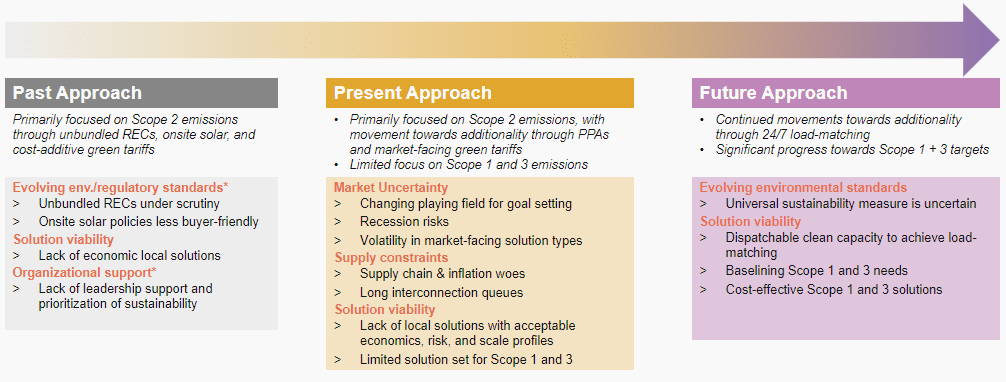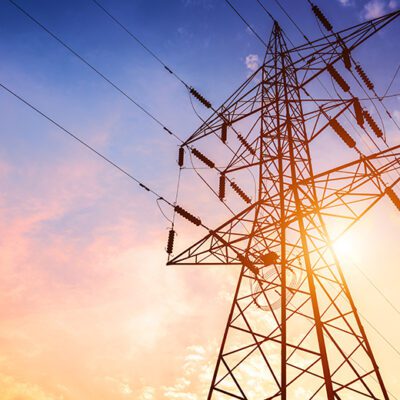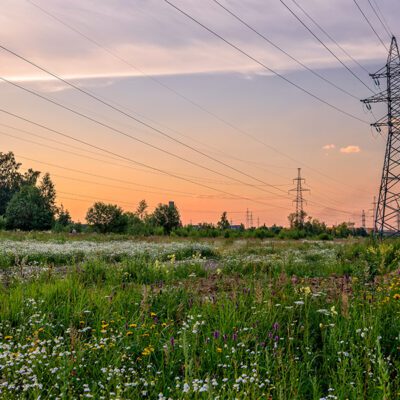Large companies now have many options for buying clean energy, often from sources that are not their electric utility. This is a missed opportunity for those utilities. When thoughtfully designed with the needs of commercial buyers in mind, utility clean energy programs can help attract, retain, and grow commercial accounts—presenting a valuable business opportunity.
How Are Commercial Buyers Meeting Clean Energy Goals?
The methods companies use to source clean energy have evolved significantly over time.
In the past, companies focused on addressing Scope 2 emissions through renewable energy purchases. Their options were limited to unbundled renewable energy credits (RECs), which do not directly put more clean power on the grid (a.k.a., lack “additionality”); onsite solar, which is not scalable; and green tariff programs, which, at the time, were limited and posed poor economics.
Now, companies are taking a more holistic view of their carbon footprints. The number of buyers with a science-based emissions target covering scopes 1, 2, and 3 has grown exponentially. They are looking at a wider array of solutions, such as virtual power purchase agreements (VPPAs), 24/7 load matching, community solar, market-facing green tariffs, electrification, carbon offsets, renewable natural gas, hydrogen, etc. Although some of these solutions are nascent, buyers must weigh economic, scalability, and decarbonization considerations prior to implementation.
These shifts are, in part, driven by changing expectations among NGOs; see below.
What Challenges Do Commercial Clean Energy Buyers Face?
The unyielding growth of commercial clean energy procurement belies the truth that buying clean energy today can be very hard.
PPA markets have been turbulent for a while, with prices on a steady climb. Public policies like net metering, which can make or break the economic feasibility of onsite solar, vary state to state and are liable to change. Limping supply chains, trade barriers, and long interconnection queues have limited the availability of attractive renewable energy projects.
Meanwhile, the goal posts are shifting. The GHG Protocol Scope 2 Guidance, which is the rulebook for how corporates measure their emissions from electricity, currently allows for corporates to choose between location-based or market-based GHG accounting. In other words, corporates can choose whether to report the emissions created by the electricity they physically use at their sites, or the electricity they help finance via a PPA, which could be flowing through a grid on the other side of the country. This gives corporates huge flexibility in how they claim emissions reductions.
That might change. The GHG Protocol is considering a new rule that would mandate the location-based method. Alternatively, buyers may be allowed to continue using the market-based method, but unbundled RECs would be disallowed, meaning that all RECs must be attached to a real-life, new clean energy project.
Clean Energy and Climate Challenges Over Time

How Utilities Can Better Serve the Commercial Clean Energy Buyer
This is a great time for utilities to begin offering new and improved clean energy programs and give their commercial customers a way around the risks and pitfalls described above.
Programs like green tariffs, community solar, demand response, electrification incentives, or onsite solar and battery storage can be game changers for commercial buyers, if structured well. We recommend utilities take the following steps to make their commercial clean energy programs attractive and competitive in today’s clean energy market:
- Shield customers from market exposure. There is significant uncertainty in the PPA market on the cost and revenue side at the moment. Utilities have the opportunity to provide a de-risked alternative to customers seeking an economically predictable pathway to decarbonization.
- Alignment with accounting principles. Sustainability accounting principles are evolving to drive deeper decarbonization. Utilities should ensure programs marketed to customers adhere with not just the latest sustainability principles, but prospectively addresses future tweaks as well.
- Programmatic expansion. Integrated tailored solutions are key to holistically address customers’ decarbonization needs. Bifurcated business solutions must be unified to provide Scope 1 and Scope 3 baselining, solution mapping, and implementation support services. Electrification and EV charging offerings will be key in enabling the next frontier of decarbonization.
- Intentional education and marketing. Program success is largely tied to customer understanding and buy-in. To ensure uptake, utilities must consistently engage customers with intent to drive program understanding, enthusiasm, and, ultimately, enrollment.
How Big is This Opportunity?
Despite year-over-year increases in commercial clean energy procurement, companies still have a very long way to go. Most have not reached 100 percent renewable energy, but even those that have cannot rest on their laurels. As they grow, they will need clean energy supply to keep pace.
To illustrate, look at these three tech companies that reached 100 percent renewable energy as of 2021. The electrical loads of each are projected to increase significantly by 2030, meaning significant amounts of clean energy are needed to fill the gap. And because leaders now recognize the importance of additionality, the gap will be filled primarily with new wind, solar, and other types of clean energy projects.
| Company | US Load 2021 (MWh) | % RE 2021 | US Load 2030 (MWh) | Need to Procure by 2030 (MWh)* |
| 7.9M | 100% | 12.3M | 3.2M | |
| Intel | 5.6M | 100% | 8.6M | 3.9M |
| Microsoft | 8.5M | 100% | 13.2M | 1.3M |
*Estimate accounts for emissions of local fuel mix
Over the next decade and beyond, utilities will play a key role in grid decarbonization through the roll out of integrated holistic customer offerings, scope 1 and 3 baselining, mapping, and implementation support, and broad customer education.
As the market and customer needs evolves, a trusted advisor can help you maximize value and avoid potential pitfalls. Learn more about how we work with utilities.



